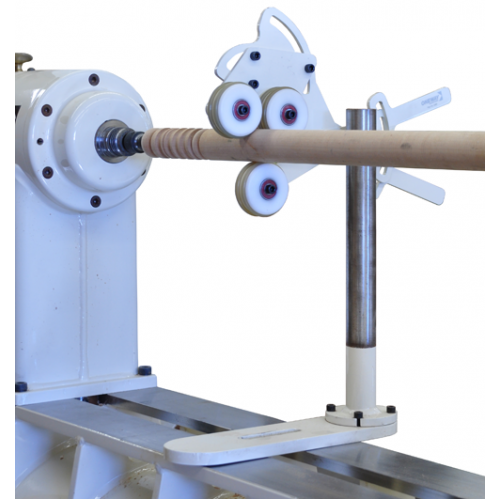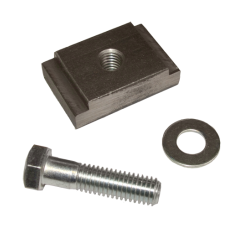Oneway spindle steady.
Prices incl. VAT plus shipping costs
Ready to ship today,
Delivery time appr. 1-3 workdays
Oneway Spindle Steady
Take control of your spindles with our easy to mount and operate steady rest, ensuring each spindle is a more enjoyable experience.
Reduce vibration of spindles from ½" to 3" in diameter.
PACKAGE INCLUDES
Tension Arm Assembly
Wheels (3)
1¼" Post
Slotted Base
Hardware Package
Clamp Block (lathe specific, please state what clamp block required with order)
What is "Bed Gap"?
The bed gap is the distance between the bed ways on your lathe. So a 2" gap requires a 2" clamp block!
This table shows the more common sizes of Clamp Block:
| Part No. | W | L | Bedways Gap | Lathe Description |
| 3154-125 | 1.25 | 1.63 | Tapered | |
| 3154-131 | 1.31 | 1.63 | 1 3/8 | |
| 3154-143 | 1.44 | 1.81 | 1 ½ | Delta |
| 3154-156 | 1.56 | 2.13 | 1 5/8 | |
| 3154-169 | 1.69 | 2.25 | 1 ¾ | |
| 3154-181 | 1.81 | 2.44 | 1 7/8 | Stubby |
| 3154-194 | 1.94 | 2.50 | 2 | |
| 3154-206 | 2.06 | 2.56 | 2 1/8 | |
| 3154-231 | 2.31 | 2.63 | 2 ¼ | |
| 3154-244 | 2.44 | 3.06 | 2 ½ | Woodfast Powermatic 3520, Stratos XL, Vicmarc VL300 & VL175 |
| 3154-256 | 2.56 | 3.19 | 2 5/8 | |
| 3154-269 | 2.69 | 3.31 | 2 ¾ | |
| 3154-281 | 2.81 | 3.44 | 2 7/8 | |
| 3154-294 | 2.94 | 3.56 | 3 | |
| 3154-306 | 3.06 | 3.69 | 3 1/8 |
Why a Spindle Steady?
Woodturning is all about vibration and how you deal with it. Vibration can become a problem in the following situations:
- spinning out of balance workpieces
- excess play in the spindle bearings
- flexibility of the wood
No matter how good the lathe is that you are turning on, the machine cannot stop vibration caused by flexibility inherent in the wood. Spindle turners have been using steady rests for as long as people have been turning wood, but traditional spindle steady's tend to be large heavy pieces of equipment which are awkward or cumbersome to use.
The ONEWAY Spindle Steady uses a unique "scissor" clamping mechanism which allows you to move and adjust it a lot more quickly and easily than traditional steady's.
The Spindle Steady is easy to put on the lathe, and on most lathes can be mounted at any time. It uses up virtually no swing, and most importantly dampens most vibration. With less vibration problems, you can employ a wider variety of cuts and cutting styles to get the finish you want.
Feedback from turners testing the design has been extremely positive.
Left or Right Handed?
It doesn't matter! When assembling the Spindle Steady, you can assemble it for either left or right-handed operation.
Increased Safety
The Spindle Steady also increases the safety factor. When turning a spindle, you no longer have to try to support it with your hand. A nasty catch can break a spindle, or at least create an ugly gouge in the spindle, and if you are supporting it with your hand, you could get badly hurt.
Using the Spindle Steady
Position the spindle steady on your machine so that the post is at the back. Adjust the height of the tension arm assembly to vertically center the tension arm assembly with the spindle (exact height adjustment is not critical).
Loosen off all the wingnuts, open up the tensioning arms and slide the base forward until the bottom wheel is close to bottom dead center on the spindle you’re turning. Tighten the base to the lathe bed.
Once the spindle steady is securely fastened to the lathe, squeeze the tension arms with light pressure to bring the wheels into contact with the spindle. Be careful not to pull up or push down on the tensioning arms as this will deflect the spindle.
Tighten all the wing nuts starting with the two that clamp the arms, and finish with the two that clamp the swivel block.
ASSEMBLY
The Spindle Steady requires some basic assembly prior to use. It can be assembled for either left or right-hand operation.
WEIGHT
Approx. 12 lbs
An ingenious and effective tool
I am a relative beginner and bought the Oneway Spindle Steady to turn 18-inch beaded spindles for table lamps. I was slightly concerned that in the picture it didn’t look as solidly constructed as some, however it turned out to be very effective, cutting out vibration that otherwise made it virtually impossible (for me!) to achieve a clean finish.
The mechanism is ingenious; you set the height of the steady on its stand to your lathe centre height and locate the bottom wheel under the work. You then lightly squeeze the 2 scissor handles at the back to set the pressure of the wheels against the work, the top two of which are on a separate pivoting arm. Gently nipping up the nuts completes the procedure. It takes a little practise to get the hang of it, but it is quick enough to re-position the steady as you work along the spindle in increments, which I found to be necessary for the best result.
The design has several benefits over other designs: It allows the pressure to be set for all 3 wheels at once and locked off with one nut before tightening the other 2; I guess this is likely to be most helpful with long thin spindles. The pivot-arm design means that the steady does not have a frame defined by the largest spindle diameter. This allows you to locate the steady closer to the cutting point without restricting tool access thus improving support. Many spindle rests are manufacturer or even lathe specific or have limited height adjustment. The Oneway steady is very flexible covering a wide range of centre heights and bed configurations by virtue of purchasing a specific bed block to fit your lathe – Simon will quickly advise you here. This means it shouldn’t be a casualty of a future lathe upgrade! Overall, an ingenious, effective and flexible spindle steady that is well designed and constructed, and particularly good value for money from Hope Woodturning.




























